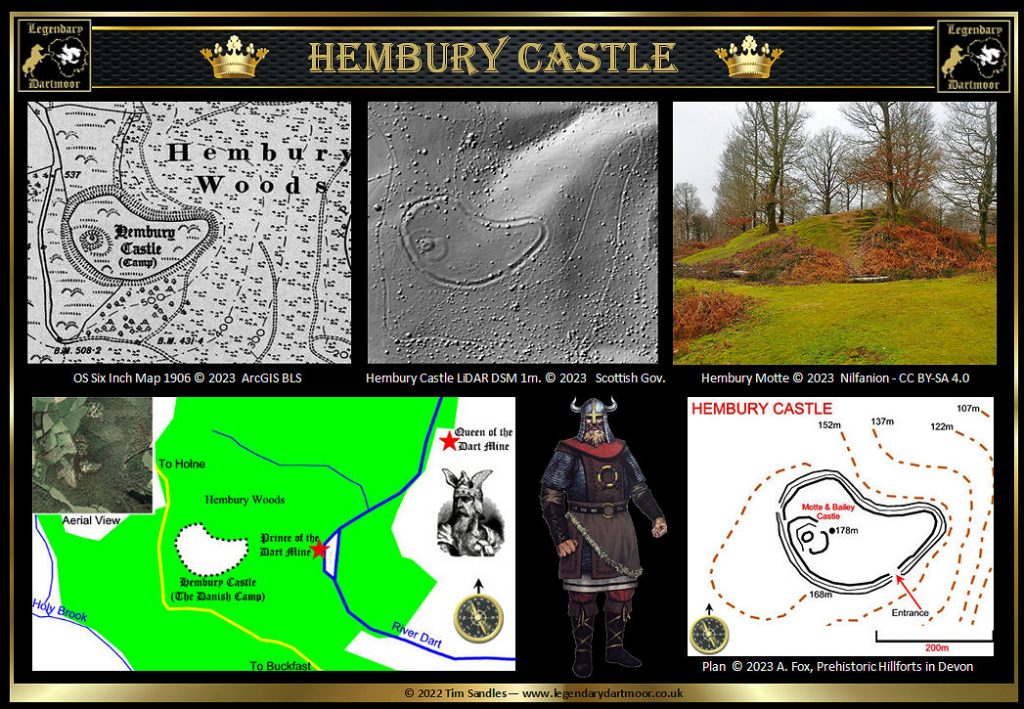
Back in the Dark Ages nobody was safe from the marauding bands of Vikings that plundered the coasts. The sleek, low draughted boats could take them up many of the English rivers and it was only a matter of luck if they were looking to trade or seeking to plunder. Such a band came up the Dart and they were definitely not looking to trade. As soon as the Viking hoard had found a suitable place to land they began their bloodthirsty spree. Initially their aim was to steal horses so scouts could go in search of suitable settlements to ransack. Once they had found rich pickings they returned with the rest of the warriors.
It so happened that such a scouting party found the small castle of Hembury and realised that although it had steep ramparts and high palisades it would not be too much of an effort to capture it. A warrior was sent back to get the rest of the raiding party whilst the remainder kept a secret but careful watch of the small hillfort. Needless to say the war band returned and a bloody battle commenced. Step by step they gained ground and soon were inside the fortification, once in they slaughtered any of the Saxon defenders that were brave enough to stay, the rest fled to regroup and plan a counter attack. The Viking barricaded and reinforced the huge gates and as night was drawing in they made camp for the night. Many of the Hembury womenfolk had hidden themselves in their small huts and one by one as the barbarians pillaged each home they were discovered. It is a well known fact that the Vikings were interested in two things pillaging and raping, so having accomplished the first they turned their attentions to the second. Having forced the women to cook supper the lusty men from the north each took a woman for the night. Now these women were sly, they knew that the men folk were planning to recapture the settlement and so obligingly they complied with their capturers wishes. Their ordeals were soon over and the poor exhausted Vikings began to fall asleep, after all it had been a busy day – and an even busier night. Every woman stayed with her abuser and once they heard the loud pig-like snores the women drew their sharp Scramaseaxs’ and slit the Viking’s throats. Once this deed was done they flung open the gates to the waiting warriors who stormed back inside the stronghold and dispatched any of the invaders that were left breathing. From that day onwards Hembury Castle was known as ‘The Danish Camp’.
One of the early descriptions of Hembury Castle is made by Page, 1895, p.234. He gives a delightful early antiquarian’s view of the site: “The ramparts are double, with a deep fosse, and enclose a prætorium now covered with oaks, which stands at the south-west corner. On the inside it is encircled by a low vallum. We shall find some difficulty in tracing the line of the ramparts, as they are covered in thick scrub. Mr Woollcombe, the great authority on the hill camps of Devonshire, says that they ‘are all very entire, and the ditches on the south-west and part of the north sides are still deep, having been forty feet in width. On the north and east the ground sinks so precipitously as to from a natural fence. The prætorium he imagines of later construction, and from its being such a complete mound, considers that it might have been erected in Norman times. Owing to the fact that it is not connected with any road traversing the county, he does not think it was added by the Romans, as he sees no reason for its occupation by them. Besides a bronze Celt, a large number of oval stones have been discovered here, which Polwhele doubts not were the sling-stones of the ancient Britons.”
There are those who think that Hembury was a Danish fort. According to a local legend, it was won from the invaders by the strategy of women, who allowing themselves to be captured by the pirates, cut their throats during the night. The name has been traced to ‘Hiarn’, a Viking known to have made descents upon the north and north-west (but apparently not the south-west) shores of Britain.”For a modern archaeologists description of the site Fox, 1996, p.37, states that it is a large hillfort with a Norman motte and bailey castle which was built later. The 7½ acre (3 hectares) enclosure is defended by a deep ditch and rampart with a steep counter-scarp bank. The forts entrance is on the lower southern side where access is gained by a 26½ft (8m) wide causeway which crosses the ditch. The small Norman motte and bailey castle would have been added sometime between the 11th and 12th centuries. It is located on the western side of the prehistoric enclosure where the adjoining Iron Age defences were broadened and heightened. A timber tower would have probably been erected in the central hollow of the motte.
The English Heritage NMR description for the Iron Age hillfort is as follows: “Earthwork remains of an Iron age univallate hillfort; a bronze axe and sling stones were also found on the site.” It is classed as a multi-period feature dating to the Bronze and Iron Ages. The Norman motte castle is recorded as: “Motte and Bailey set within an Iron Age hillfort. The castle is situated on the western summit of the hillfort interior. The motte consists of a central grass covered mound with an encircling ditch and bank, bailey and outer rampart. The motte is almost perfectly circular at its base, about 32 metres in diameter rising to an oval top offset to the south west quadrant and measuring 19 metres north east to south west by 11 metres overall. The remains of the bailey lie 18 metres beyond the mound.”
The fact that sling stones were discovered could suggest that at one time there was a need to defend the site from possible attack. At Danebury hillfort (Hampshire) large numbers of sling stones were discovered behind the ramparts. Cunnliffe, 2000, p.92 notes that the sling shot was a very effective weapon when used by defenders situated on top of a rampart and was an “ideal weapon to drive off attackers who would be entirely exposed in their approach.” He also estimates that a shot fired from a sling could accurately hit a target at a range of c.130ft (60m) It is also interesting to note that less than half a mile away a Roman curias (breastplate) was discovered (Record No. NMR_NATINV-444811) thus indicating some possible Roman activity in the area.
Bibliography.
Archaeology Data Service 2005 -on-line source found at : http://ads.ahds.ac.uk/
Cunnliffe, B. 2000 Iron Age Britain, Batsford, London.
Fox, A. 1996 Prehistoric Hillforts in Devon, Devon Books, Tiverton.
Page, J. Ll. W. 1895 An Exploration of Dartmoor, Seeley & Co., London.
 Legendary Dartmoor The many aspects past and present of Dartmoor
Legendary Dartmoor The many aspects past and present of Dartmoor

